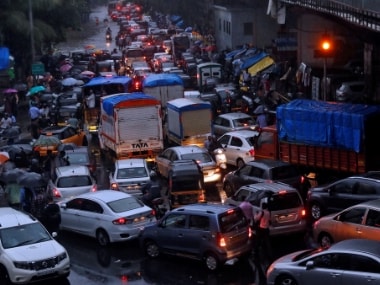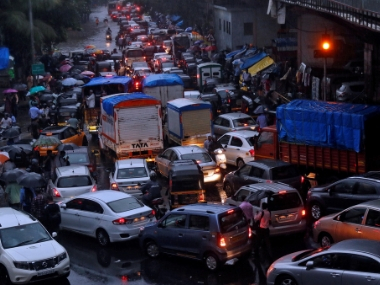Delhi and Mumbai are both megacities of our country with population in each exceeding 10 million. With this spurt, these cities also grow in terms of area. The National Capital Territory or the NCT has spread to nearly 1,500 sq km. The scale of the mega cities with the heterogeneity and complexity of activities make them prone to issues ranging from congestion, traffic jams, pollution, and other unlivable conditions. The two megacities with their growing population, and with more increasing purchasing power and resultant increased vehicle ownership, have already clogged the streets and considering the trend, the situation would worsen in the near future. The transport demand forecast by Rail India Technical and Economic Service (RITES) in 2010 showed that the arterial roads of Delhi would have more than 60,000 passenger car units per day. The Centre for Science and Environment has assessed that average traffic speed on arterial roads is 50-60 per cent lower than their design speed of 50-70 km/hour and 35-48 per cent lower than the regulated speed of 40-50 km/hour. [caption id=“attachment_5122561” align=“alignleft” width=“380”]  Representational image. Reuters[/caption] The city centres of the megacities are also characterised by diverse population base. Not being confined to one type of activity or demographics, the city centres have varied uses and activities like residential, transport terminals and nodes, and trade and commerce, both wholesale and retail with high turnover. Heritage precincts are also part and parcel of this part of the cities. Complexity of activities stem from a mix of uses ranging from the residential and commercial, industrial and commercial, and residential and industrial. The significance of such areas is not limited to the economy they generate but also the possibility of rejuvenating public spaces and improving the recreational attributes. For example, Chandni Chowk of Delhi has residential areas, bazaars/areas for commercial activities, heritage areas, activities for entertainment and storage areas. This collage of multiple activities makes these areas complex in all aspects. Since these city centres are generally the oldest parts of the cities, they see a lot of transformation. The city centres with their diverse typology, scale of activities and transformations are attraction points and act like magnets attracting people from within and beyond the city limits also thereby generating and attracting a significant share of trips. This leads to congestion in these areas creating traffic jams and disruption in the smooth flow of the traffic and also increased pollution and carbon emissions. Noise pollution is one aspect which has not been given much thought, people have adjusted or compromised with the ever increasing noise of the horns and honking in our cities, which harms the populace and increases the stress and the constant disruption in social interactions. Another inherent character of the city centres are the narrow lanes, which hinder the flow of pedestrians and creates several pedestrian and traffic conflict points. Reduction of the accessibility for the pedestrian, vehicular traffic in these narrow lanes add to the pressure on the roads and also raises questions on the safety of pedestrians. On-street parking is also a reason why the ease of movement is compromised in such areas, the comfort of the ability to freely move around is reduced due to the accumulation of vehicles. Areas are also devoted to off-street parking, making these areas a dead space which could have been a lively public recreational space otherwise. The sense of security and safety is lost in the moving busy vehicular traffic further reducing the accessibility for the elderly, children and differently-abled people. The entire public space is lost as the space which should be for people, is predominantly occupied with cars and two wheelers. So what could be the solution for these complexities? Internationally, city centres have overcome similar issues by going car-free. Examples of banning cars can be seen in New York, where popular streets in Times Square, Herald Square, and Madison Square Park are pedestrian-only. San Francisco is planning to ban cars and create bike lanes in the busy market streets. Other such examples are Camden Street in London, Boulevard Saint Laurent in Montreal, Canada, and the central district of Copenhagen. Also Milan, Dublin, Paris, Madrid and Brussels have pedestrianized their downtown hubs. What purpose would going car-free serve for our city centres? Spaces would have increased accessibility with an ease of movement for all sections of visitors. This would open up more recreational areas within a city centre, open up the lungs in terms of the open areas/green spaces that can then be increased within the otherwise-dense structure with little to no space to breathe. Shifting the focus from vehicular movement to pedestrian movement in the city centres would solve the issue of congestion and traffic jams, reducing the delay and, therefore, leading to more efficient trips; less traffic would increase accessibility and also ensure the reduction in fuel consumption, air and noise pollution. Restricting vehicular traffic is good for promoting the usage of public transport, use of green and sustainable modes of transport. The city-centre residents find such healthy, vibrant and clean environments, free of cars, blaring car horns and other nuisances, much more habitable, enjoyable and productive, not just for them, but also for the visitors to the areas. The city centres would thus be more universally accessible, more people-friendly with increased sense of pedestrian safety and reduction in accidents and general chaos. (Professor Sanjukkta Bhaduri teaches urban planning at the School of Planning and Architecture, New Delhi)
Being the oldest parts of the megacities, the city centres see a lot of transformation. Often, they act like magnets, drawing people from beyond city limits
Advertisement
End of Article


)

)
)
)
)
)
)
)
)



